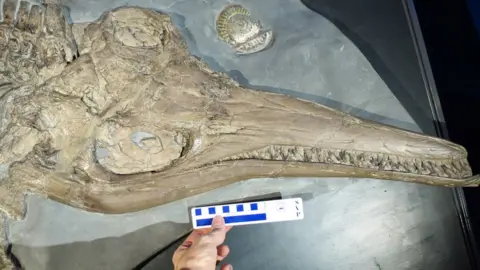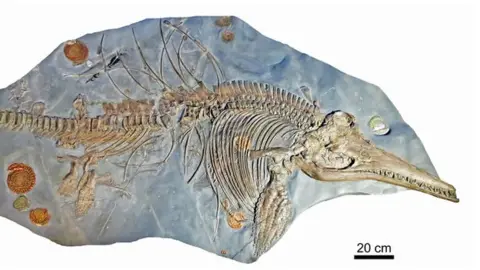'Sea dragon' fossil is 'largest on record'
 Joschua Knüppe
Joschua KnüppeThe fossil of a marine reptile ''re-discovered'' in a museum is the largest of its kind on record, say scientists.
The ''sea dragon'' belongs to a group that swam the world's oceans 200 million years ago, while dinosaurs walked the land.
The specimen is the largest Ichthyosaurus to be described, at more than three metres long.
It was discovered on the coast of England more than 20 years ago, but has remained unstudied until now.
Palaeontologist Sven Sachs saw the fossil on display at a museum in Hannover. He contacted UK palaeontologist, Dean Lomax, who is an expert on Ichthyosaurs.
''It amazes me that specimens such as this [the biggest] can still be 'rediscovered' in museum collections,'' said the University of Manchester palaeontologist.
''You don't necessarily have to go out in the field to make a new discovery.''
 Dean Lomax
Dean LomaxThe reptile belongs to the species, Ichthyosaurus somersetensis, which is named after the county in south west England where many ancient marine reptile specimens have been unearthed.
It was dug up at Doniford Bay, Somerset, in the 1990s and eventually found its way into the collections of the Lower Saxony State Museum in Hannover.
The reptile was an adult female that was pregnant at the time of death.
''This specimen provides new insights into the size range of the species, but also records only the third example of an Ichthyosaurus known with an embryo,'' added Dean Lomax. ''That's special.''
 Dean Lomax
Dean LomaxDuring the age of the dinosaurs, the ocean was home to many types of ichthyosaur or ''sea dragon''.
They appeared in the Triassic, reached their peak in the Jurassic, then disappeared in the Cretaceous - several million years before the last dinosaurs died out.
Ichthyosaurs were among the first skeletons to be discovered by early fossil-hunters, at a time when theories of evolution and concepts of geology were in their infancy.
The famous fossil hunter Mary Anning discovered the first complete fossil of an ichthyosaur in the cliffs near Lyme Regis, Dorset, in 1810.
Her discovery shook up the scientific world and provided evidence for new ideas about the history of the Earth.
The study is published in the journal, Acta Palaeontologica Polonica.
Follow Helen on Twitter.
